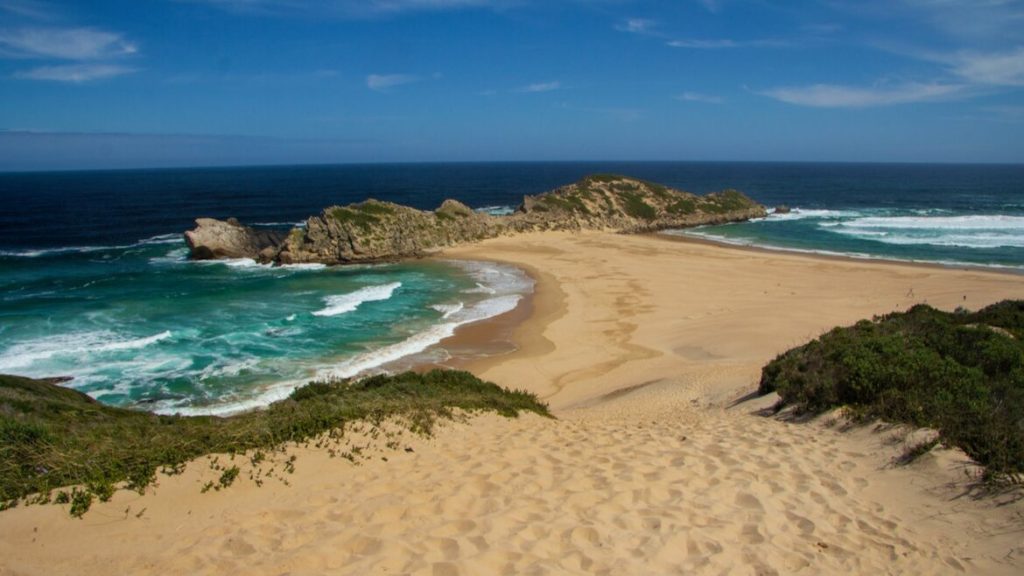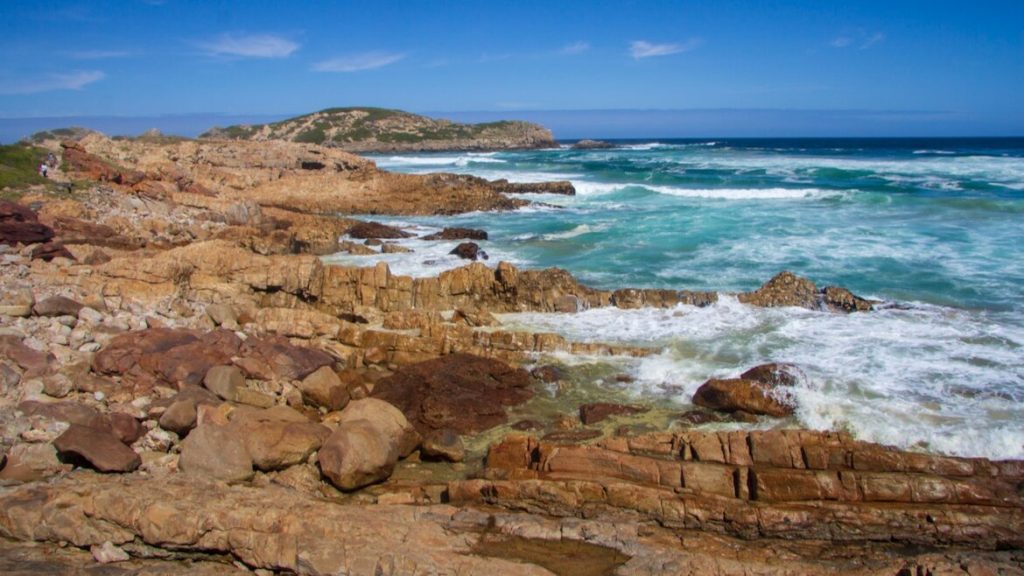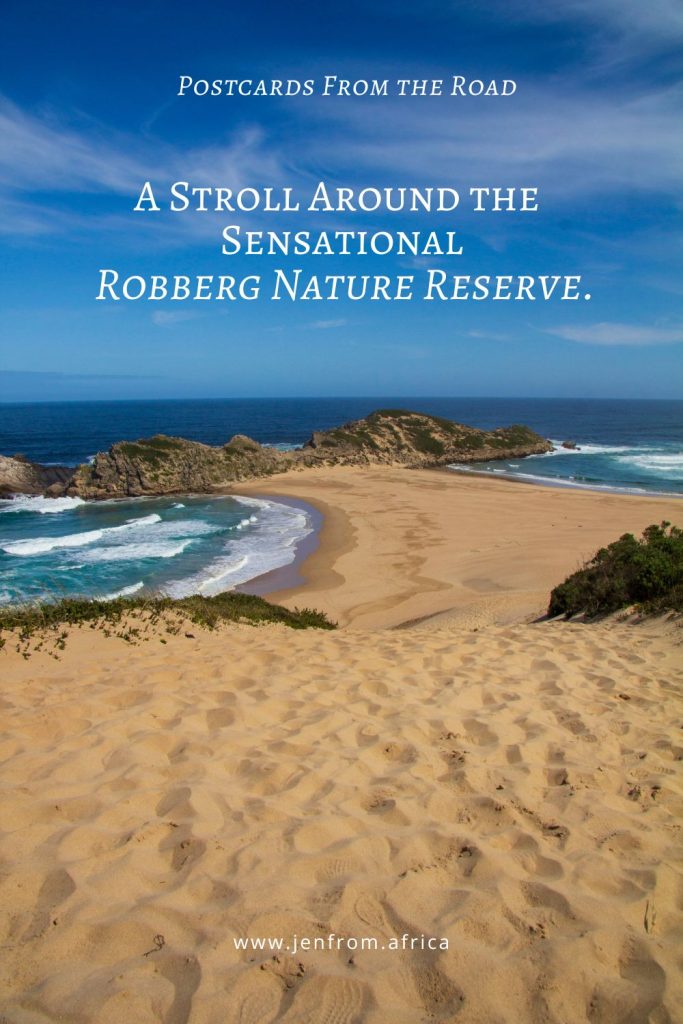‘Maybe this isn’t a good idea,’ I yell. But the ferocious wind blasting through the Robberg Nature Reserve’s parking lot whips my words away, and my husband disappears down the trail.
For a moment, I contemplate seeking shelter behind our car. I can’t hide inside it because my husband has the car keys. Sooner or later, he’ll notice I’m not behind him and come looking for me.
However, I can find no respite from this icy wind, so I follow him. After all, the there-and-back Gap hike is only a half-hour walk. How awful can it be?
Despite my initial wimpy misgivings, we find ourselves enthralled by the sensational beauty of this wild and rugged headland. So much so that we don’t want to leave. And our short half-hour stroll turned into a slow afternoon hike.
But before I tell you more,

Where is Robberg Nature Reserve?
You’ll find this rocky peninsula jutting out into the Indian Ocean about eight kilometres south of Plettenberg Bay on South Africa’s Garden Route.
Here, Mother Nature offers you epic cliff and ocean vistas that lure you on to see if the next view could be more sensational than the last.
There are no roads in Robberg Nature Reserve. Instead, this is a place for walking, with your feet in direct contact with ancient rocks thought to date back to the breakup of the supercontinent of Gondwanaland.

The Gap Hike
Of course, my husband has sensibly chosen the path on the leeward side of the Robberg peninsula. Not a single breath of wind stirs the vegetation here.
Initially, the pathway winds through tall and aromatic Montane fynbos offering occasional glimpses of the ocean far below.
Hundreds of giant green grasshoppers skitter and scatter around us in an elaborate grasshopper courtship dance.
Dassies (Rock Hyrax) keep a watchful eye on passing hikers as they sun themselves on lichen-encrusted rocks.
And above us, a colony of breeding kelp gulls flies back and forth, feeding their hungry chicks.



Without warning, the fynbos drops to knee height. It’s as if Mother Nature has diligently pruned it to better show off the jaw-dropping splendour of Robberg’s GapThe.
To our left, the calm jade waters of Plettenberg Bay gently lap at the boulders far below us. And dolphins, or maybe they are seals, it’s hard to tell, skim through the water only to disappear into the blue.
And to the right, a bejewelled green carpet of flowering fynbos leads down to a sandy beach where a constant barrage of waves rolls in from the Indian Ocean.


Why Not Hike to the Top of The Gap?
A silver balustrade leads up the left-hand side of the Gap’s cliff. Its gleaming stainless steel catches the ever-changing light filtering through the clouds enticing us to explore further.
Although the rocky trail looks quite steep, we allow ourselves to be lured up the pathway, but first, we agree only to go as far as the overhang. Afterwards, we’ll return to Plettenberg Bay for a late lunch and a bottle of wine.

But the overhang is only halfway up the hill. From here, we can see a viewing deck perched on the summit. And again, Mother Nature lures us onwards with the promise of an even better view. But only after we agree that this will be our last stop here.
The air is still. It’s hard to believe that we were buffeted by strong winds half an hour ago.
We follow the steep path up a series of natural rock steps. Some are small steps, but most are high, and my knees begin to protest. We’re both panting by the time we flop down on the deck.
A delightful breeze fans our brows as we catch our breath. But this deep breathing isn’t only about our lack of fitness. The beauty of the spectacular 180-degree panorama around us is simply breathtaking.

Why Not Hike a Little Further?
After all, we’ve come this far. The worst of the climb appears to be behind us. And we believe there is a Cape fur seal colony not much further down the pathway.
And once again, Mother Nature lures us onward. Only this time, we don’t bother making idle promises to return once we’ve seen the seals. All thoughts of that lazy lunch have been erased from our minds.
We stroll through a mosaic of white, yellow and purple flowering fynbos that lines the flat, rocky pathway. Silver-leafed plants shimmer in the light as the breeze caresses their foliage.
Deep inside the dense vegetation, unseen birds chirp and trill their sweet songs.
A melange of delicate fynbos aromatics lightly tinged with salt embraces us. And every so often, a break in the fynbos gifts us with sublime views of the ocean.
Until we walk through an invisible barrier of suffocating odours.

The Cape Fur Seals are Truly a Smelly Bunch.
A stomach-churning stench assaults our nasal passages sticking in the back of our throats. After the beautiful aromatics of the fynbos, the desire to vomit is strong. I’m about to suggest we turn back, but then we hear barking.
Could that be the Cape fur seal colony that gave this wild place its name? Robberg means ‘seal mountain’ in Dutch.
We round the bend, and Mother Nature offers us a spectacular bird’s eye view of the Cape fur seals basking and bickering on a sandy shelf. While others frolic in the calm jade-green waters nearby.
We’d love to stay and watch their antics, but this eye-watering stench is overwhelming.

The Witsand Dune
Mother Nature soon soothes our battered nasal passages with a cleansing salty breeze and yet another picturesque view.

And now, the prehistoric rock beneath our feet disappears, and we find ourselves trudging through thick white sand down into yet another dip.
But this one is different. It’s a giant dune. Or rather, more accurately, one of seven climbing-falling dunes.
A small island on the wild side of Robberg Nature Reserve traps sand driven ashore by wind and currents. When the sand dries, the wind blows it up the seven dunes. Where In time, the sand will eventually slide down into Plettenberg Bay.


A Small Slice of Eden.
Halfway down the dune, we flop down onto its soft white sands. Wordless, we sit in quiet awe at Mother Nature’s glorious handiwork.
A light breeze caresses our bodies. Its crisp, salty scent carries subtle hints of tangy brine.
The ocean soothes our eyes with almost every imaginable shade of tranquil blue.
And seabirds fish from the island’s rocks. But the crashing waves on either side of a narrow beach connecting the island to the Robberg peninsula drown out their cries of victory.
This must be Eden. And I never want to leave this spot.
And then, my husband says, ‘do you think the tombolo is getting narrower?’
‘A tombolo. I think you mean isthmus?’ With a patient sigh, he explains that a tombolo connects an island to the mainland, while an isthmus connects two large land masses.
He’s right on both counts, and the tide is coming in. It’s time to bid farewell to this delightful slice of Eden.

Beware of Strong Winds.
We have a choice. Either we retrace our steps or hasten along the rocks of the wild side and hope Mother Nature holds back the tide for us. With a quick beseeching prayer to Mother Nature, we head off along the rocks.
After our misery on the nearby Storms River Waterfall Trail, where we were reduced to scrambling and crawling across the rocks, this is a walk in the park. We’re making good time and should beat the incoming tide.

But a small challenge lies ahead. The rocks taper down to a narrow ledge where a thin concrete walkway hugs the base of the cliff.
Thundering waves roar up to the bottom of the ledge only to be defeated by its slope. Undeterred, they send small wavelets coursing up to touch the walkway as emissaries of impending slipperiness.
As if this isn’t frightening enough. A friendly-looking sign warns us to beware of strong winds. Alarmed, we pick up our pace. Who knows when or where the ocean will spit us out if we slip here?

I’m verging on panic, and then we round another corner, and there ahead of us lies safety. A staircase leads up to a wooden walkway set high above the rocks and the incoming tide. And the seemingly gentle beauty of the Gap.
Except here, my parking lot friend awaits us. Its icy breath pours through the break in the headland with a vengeance.

The Robberg Nature Reserve Experience.
Robberg Nature Reserve is one of those natural wonders that must be experienced.
It’s a place of contrasts between the gentle protected eastern side and the raw, wild western side that invokes each sense.
On the eastern side, the delicate aromas of fynbos tinged with salt delight our noses until the pungent smell of cape fur seals assaults them leaving us gasping. Only to be cleansed a little while later by a salty sea spray on the western ‘wild’ side.
A light sea breeze fans our sweaty hiker’s brow on the eastern side while strong, icy winds pummel our bodies on the ‘wild’ side.
A soft susurration of waves lapping the boulders far below us and the plaintive ‘meeu’ of kelp gulls accompany us along the leeward side. And on the wild side, the ocean thunders and roars, drowning out all other sounds.
And at each corner or new elevation, yet another riveting cliff and oceanscape roots you to the spot, mesmerised by Mother Nature’s sensational beauty.
It’s rough yet serene, and it’s wild yet tame. But most of all, it’s so incredibly beautiful that we didn’t want to walk away.

Robberg Nature Reserve Good to Know:
How Long is the Robberg Nature Reserve Hike?
The Robberg Nature Reserve Point hike starts in the parking lot and circumnavigates the peninsula. At two natural breaks in the headland, namely the Gap and Witsand, the route cuts across from one side to the other, and now you have a choice of three circular routes.
The Gap Hike.
From the parking lot, it’s a comfortable two-kilometre stroll except for one steep section on the circular route. But I promise you the views are worth it. It should take half an hour to an hour, depending on how often you stop to admire the views.
Witsand Hike.
We ended up hiking the Witsand route. This route continues from the mudstone cleft of the Gap and is 5.5 kilometres in total. In theory, Witsand is a 2-hour hike. But if, like us, you stop to smell the fynbos and take in all that Mother Nature has to offer, it will take you about four hours.
The Point Hike.
The round trip to the Point is a strenuous 9.2 kilometres. And it isn’t recommended for children as there are steep rocky slopes and sheer drops along the path.

Or, if you’d prefer a hard copy, click this link to download the map from CapeNature’s website.
An Important Robberg Hiking Tip
If you explore Robberg past the Gap, walk around in a clockwise direction because climbing up the Witsand dune is an 80-meter trudge through thick sand. I promise you your body will thank you later.
Robberg Nature Reserve’s beauty isn’t Free.
You will need to buy a permit from Cape Nature to enter Robberg. If you’re a Wild Card holder, entry is free, but remember to take your card.
In November 2023, entry permits for a day cost:
- ZAR 60.00 for adults,
- ZAR 40.00 for children.
You can purchase your permits at the reserve gate. But do take along cash as the card machine wasn’t working the day we were there.
And Don’t Forget …
Baz Luhrmann’s sage advice to the class of ’99 – wear sunscreen. The sun along this coastline has a fierce bite.
Wear comfortable walking shoes and a hat, and layer your clothing. Despite visiting in early summer, that wind was icy. And in winter, don’t forget a raincoat.
Take plenty of water and a snack or two.
And whatever you do, don’t forget to take your camera.
DISCLOSURE: I don’t have any commercial relationship with CapeNature, SANParks Wildcard or any of their affiliates. All photographs, experiences and opinions expressed in this blog post are my own.
Are you on Pinterest? Why not save one of my pins to read for later?



And if you have also strolled around Robberg, I’d love to hear about your hike in the comments below.

2 comments
Oh what a fabulous place! And what a hike, enticement after enticement, until you almost didn’t get back. Beautiful photos Jen, and a good read.
I’m so glad you enjoyed the read, Alison.